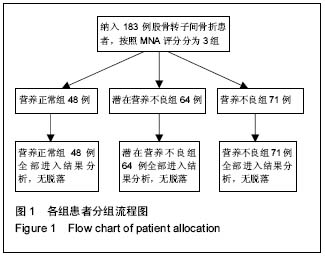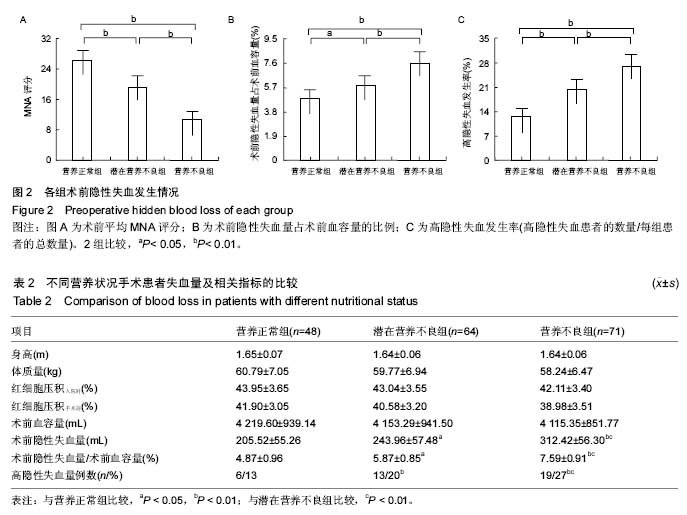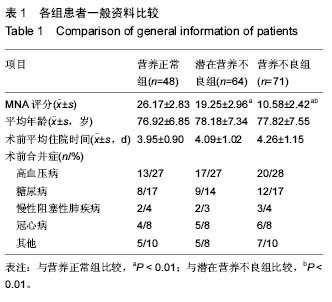| [1] Brauer CA, Coca-Perraillon M, Cutler DM, et al. Incidence and mortality of hip fractures in the United States. JAMA. 2009;302:1573-1579.
[2] Johnell O, Kanis JA. An estimate of the worldwide prevalence, mortality and disability associated with hip fracture. Osteoporos Int. 2004;15:897-902.
[3] Boddaert J, Raux M, Khiami F, et al. Perioperative management of elderly patients with hip fracture. Anesthesiology. 2014;121:1336-1341.
[4] Boddaert J, Cohen-Bittan J, Khiami F, et al. Postoperative admission to a dedicated geriatric unit decreases mortality in elderly patients with hip fracture. PLoS One. 2014;9:e83795.
[5] Murphy MC, Brooks CN, New SA, et al. The use of the Mini-Nutritional Assessment (MNA) tool in elderly orthopaedic patients. Eur J Clin Nutr. 2000;54:555-562.
[6] Guigoz Y, Vellas B, Garry PJ. Assessing the nutritional status of the elderly: The Mini Nutritional Assessment as part of the geriatric evaluation. Nutr Rev. 1996;54: S59-65.
[7] Dwyer JT, Gallo JJ, Reichel W. Assessing nutritional status in elderly patients. Am Fam Physician. 1993; 47:613-620.
[8] Scholl R. Nutrition and aging: assessing the nutritional status of the elderly patient. J Kans Med Soc. 1982;83: 368-370.
[9] Fiatarone Singh MA. Exercise, nutrition and managing hip fracture in older persons. Curr Opin Clin Nutr Metab Care. 2014;17:12-24.
[10] Foss NB, Kehlet H. Hidden blood loss after surgery for hip fracture. J Bone Joint Surg Br. 2006;88: 1053-1059.
[11] Smith GH, Tsang J, Molyneux SG, et al. The hidden blood loss after hip fracture. Injury. 2011;42:133-135.
[12] Yasunaga H, Tsuchiya K, Matsuyama Y, et al. High-volume surgeons in regard to reductions in operating time, blood loss, and postoperative complications for total hip arthroplasty. J Orthop Sci. 2009;14:3-9.
[13] Li J, Cheng L, Jing J. The Asia proximal femoral nail antirotation versus the standard proximal femoral antirotation nail for unstable intertrochanteric fractures in elderly Chinese patients. Orthop Traumatol Surg Res. 2015;101(2):143-146.
[14] He W, Zhang W. The curative effect comparison between prolonged third generation of gamma nail and prolonged dynamic hip screw internal fixation in treating femoral intertrochanteric fracture and the effect on infection. Cell Biochem Biophys. 2015;71: 695-699.
[15] Inal S, Taspinar F, Gulbandilar E, et al. Comparison of the biomechanical effects of pertrochanteric fixator and dynamic hip screw on an intertrochanteric femoral fracture using the finite element method. Int J Med Robot. 2015;11:95-103.
[16] Xu Z, Zhang M, Yin J, et al. Redisplacement after reduction with intramedullary nails in surgery of intertrochanteric fracture: cause analysis and preventive measures. Arch Orthop Trauma Surg. 2015; 135(6):751-758.
[17] Tawari AA, Kempegowda H, Suk M, et al. What makes an intertrochanteric fracture unstable in 2015? Does the lateral wall play a role in the decision matrix? J Orthop Trauma. 2015;29 Suppl 4:S4-9.
[18] Martin-Martin LM, Arroyo-Morales M, Sanchez-Cruz JJ, et al. Factors Influencing Performance-Oriented Mobility After Hip Fracture. J Aging Health. 2015.
[19] Watt J, Cox L, Crilly RG. Distribution of vertebral fractures varies among patients according to hip fracture type. Osteoporos Int. 2015;26:885-890.
[20] Neuman MD, Rosenbaum PR, Ludwig JM, et al. Anesthesia technique, mortality, and length of stay after hip fracture surgery. JAMA. 2014;311:2508-2517.
[21] Patorno E, Neuman MD, Schneeweiss S, et al. Comparative safety of anesthetic type for hip fracture surgery in adults: retrospective cohort study. BMJ. 2014;348:g4022.
[22] Karampampa K, Ahlbom A, Michaelsson K, et al. Declining incidence trends for hip fractures have not been accompanied by improvements in lifetime risk or post-fracture survival - A nationwide study of the Swedish population 60years and older. Bone. 2015; 78:55-61.
[23] Chehade MJ, Carbone T, Awward D, et al. The influence of fracture stability on early patient mortality and reoperation after pertrochanteric and intertrochanteric hip fractures. J Orthop Trauma. 2015;29(12):538-543.
[24] Joshi D, Dhamangaonkar AC, Ramawat S, et al. Predictors of iatrogenic lateral wall fractures while treating intertrochanteric fracture femur with the dynamic hip screw system in Indian patients. Eur J Orthop Surg Traumatol. 2015;25:677-682.
[25] Sadic S, Custovic S, Jasarevic M, et al. Proximal femoral nail antirotation in treatment of fractures of proximal femur. Med Arch. 2014;68:173-177.
[26] Omsland TK, Emaus N, Tell GS, et al. Mortality following the first hip fracture in Norwegian women and men (1999-2008). A NOREPOS study. Bone. 2014;63: 81-86.
[27] Krogseth M, Wyller TB, Engedal K, et al. Delirium is a risk factor for institutionalization and functional decline in older hip fracture patients. J Psychosom Res. 2014; 76:68-74.
[28] Mendez-Gil A, Fernandez-Valencia Laborde JA, Estrada-Masllorens JM, et al. [Minimally invasive dynamic hip screw technique: Shorter surgical time with similar post-surgical results compared to conventional DHS technique. A retrospective cohort study]. Rev Esp Cir Ortop Traumatol. 2014;58: 351-356.
[29] Schwartsmann CR, Jacobus LS, Spinelli Lde F, et al. Dynamic hip screw for the treatment of femoral neck fractures: a prospective study with 96 patients. ISRN Orthop. 2014;2014:257871.
[30] Kazemian GH, Manafi AR, Najafi F, et al. Treatment of intertrochanteric fractures in elderly highrisk patients: dynamic hip screw vs. external fixation. Injury. 2014;45: 568-572.
[31] Ha YC, Park YG, Nam KW, et al. Trend in hip fracture incidence and mortality in Korea: a prospective cohort study from 2002 to 2011. J Korean Med Sci. 2015;30: 483-488.
[32] Kronborg L, Bandholm T, Kehlet H, et al. Municipality-based physical rehabilitation after acute hip fracture surgery in Denmark. Dan Med J. 2015; 62(4): A5023.
[33] Goisser S, Schrader E, Singler K, et al. Malnutrition According to Mini Nutritional Assessment Is Associated With Severe Functional Impairment in Geriatric Patients Before and up to 6 Months After Hip Fracture. J Am Med Dir Assoc. 2015;16(8):661-667.
[34] Barne M. Oral nutritional support in hip fracture patients. Br J Community Nurs. 2014;Suppl:S6, S8.
[35] Bell JJ, Bauer JD, Capra S, et al. Concurrent and predictive evaluation of malnutrition diagnostic measures in hip fracture inpatients: a diagnostic accuracy study. Eur J Clin Nutr. 2014;68(3):358-362.
[36] Drevet S, Bioteau C, Maziere S, et al. Prevalence of protein-energy malnutrition in hospital patients over 75 years of age admitted for hip fracture. Orthop Traumatol Surg Res. 2014;100(6):669-674.
[37] Cram P, Lu X, Kaboli PJ, et al. Clinical characteristics and outcomes of Medicare patients undergoing total hip arthroplasty, 1991-2008. JAMA. 2011;305: 1560-1567.
[38] Duncan DG, Beck SJ, Hood K, et al. Using dietetic assistants to improve the outcome of hip fracture: a randomised controlled trial of nutritional support in an acute trauma ward. Age Ageing. 2006;35:148-153.
[39] Vermesan D, Trocan I, Prejbeanu R, et al. Reduced operating time but not blood loss with cruciate retaining total knee arthroplasty. J Clin Med Res. 2015;7: 171-175.
[40] Gill R. Practical management of major blood loss. Anaesthesia. 2015;70 Suppl 1:54-57, e19-20.
[41] Yang Y, Lv YM, Ding PJ, et al. The reduction in blood loss with intra-articular injection of tranexamic acid in unilateral total knee arthroplasty without operative drains: a randomized controlled trial. Eur J Orthop Surg Traumatol. 2015;25:135-139. |
.jpg) 文题释义:
营养不良:因蛋白质、能量及其他营养素摄入不足或过度,导致机体功能乃至临床预后出现不良影响。
隐性失血:围手术期显性出血明显减少,但术后血红蛋白量和红细胞压积下降程度却与手术引起的失血量明显不符,国外学者将这种现象定义为“隐性失血”。
文题释义:
营养不良:因蛋白质、能量及其他营养素摄入不足或过度,导致机体功能乃至临床预后出现不良影响。
隐性失血:围手术期显性出血明显减少,但术后血红蛋白量和红细胞压积下降程度却与手术引起的失血量明显不符,国外学者将这种现象定义为“隐性失血”。.jpg) 文题释义:
营养不良:因蛋白质、能量及其他营养素摄入不足或过度,导致机体功能乃至临床预后出现不良影响。
隐性失血:围手术期显性出血明显减少,但术后血红蛋白量和红细胞压积下降程度却与手术引起的失血量明显不符,国外学者将这种现象定义为“隐性失血”。
文题释义:
营养不良:因蛋白质、能量及其他营养素摄入不足或过度,导致机体功能乃至临床预后出现不良影响。
隐性失血:围手术期显性出血明显减少,但术后血红蛋白量和红细胞压积下降程度却与手术引起的失血量明显不符,国外学者将这种现象定义为“隐性失血”。


.jpg) 文题释义:
营养不良:因蛋白质、能量及其他营养素摄入不足或过度,导致机体功能乃至临床预后出现不良影响。
隐性失血:围手术期显性出血明显减少,但术后血红蛋白量和红细胞压积下降程度却与手术引起的失血量明显不符,国外学者将这种现象定义为“隐性失血”。
文题释义:
营养不良:因蛋白质、能量及其他营养素摄入不足或过度,导致机体功能乃至临床预后出现不良影响。
隐性失血:围手术期显性出血明显减少,但术后血红蛋白量和红细胞压积下降程度却与手术引起的失血量明显不符,国外学者将这种现象定义为“隐性失血”。